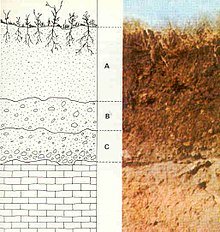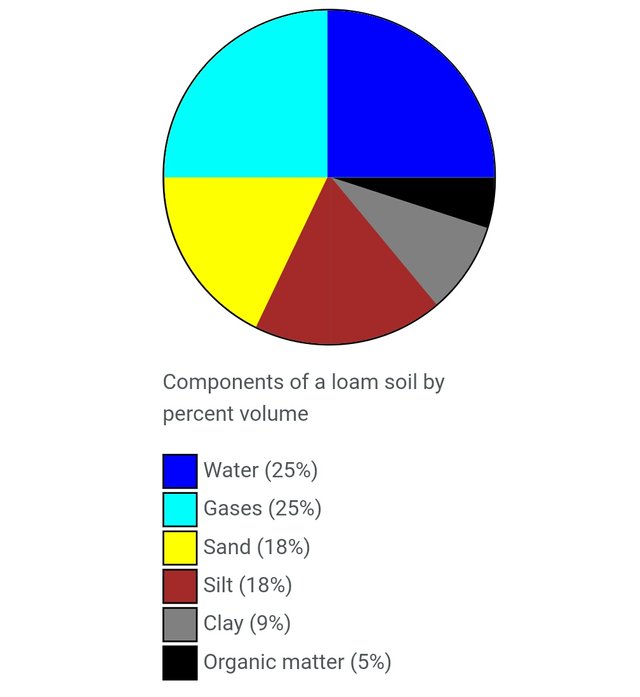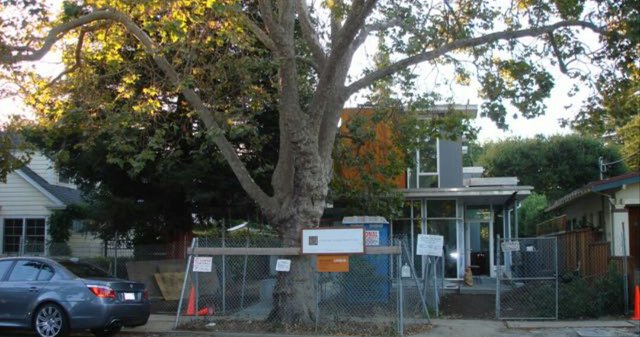The Unbelievable Soil.

Soil is a Combination of minerals, organic matter, gases, organisms, and liquids that are join together to support life. The Earth's body of soil is the pedosphere, which has 4 important functions: it is a medium for plant growth; it is a means of water storage, supply and purification; it is a modifier of Earth's atmosphere; it is a habitat for organisms; all of which, in turn, modify the soil.
Soil interfaces with the lithosphere, the hydrosphere, the atmosphere, and the biosphere. The term pedolith, commonly use to refer to the soil, translates to ground stone. Soil consists of a solid phase of minerals and organic matter (the soil matrix), as well as a porous phase that holds gases (the soil atmosphere) and water (the soil solution). Accordingly, soils are often treated as a three-state system of solids, liquids, and gases.

Soil is a commodity of the influence of climate, relief(elevation, orientation, and slope of terrain), organisms, and its parent materials (original minerals) interacting over time. It continually undergoes development by way of numerous chemical, physical and biological processes, which include weathering with associated erosion. Given its complexity and strong internal connectedness, it is considered an ecosystem by soil ecologists.
Soil science has 2 main branches of study: edaphology and pedology. Edaphology is relate with the influence of soils on living things.
Pedology is concentrated on the formation, description (morphology), and classification of soils in their natural environment. In Engineering terms, soil is included in the broader concept of regolith, which also includes other loose material that lies above the bedrock. Soil is Mainly referred to as earth or dirt; technically, the term dirt should be restricted to displaced soil.
Function Of Soil
1.Soil is a main component of the Earth's ecosystem. The world's ecosystems are impacted in far-reaching ways by the processes carried out in the soil, from ozone depletion and global warming, to rainforest destruction and water pollution. With respect to Earth's carbon cycle, soil is an important carbon reservoir, and it is potentially one of the most reactive to human disturbance and climate change. As the planet warms, it has been predicted that soils will add carbon dioxide to the atmosphere due to increased biological activity at higher temperatures, a positive feedback (amplification). This prediction has, however, been questioned on consideration of more recent knowledge on soil carbon turnover.
2.Soil behave as an engineering medium, a habitat for soil organisms, a recycling system for nutrients and organic wastes, a regulator of water quality, a modifier of atmospheric composition, and a medium for plant growth, making it a critically important provider of ecosystem services. Since soil has a tremendous range of available niches and habitats, it contains most of the Earth's genetic diversity. A gram of soil can contain billions of organisms, belonging to thousands of species, mostly microbial and in the main still unexplored. Soil has a mean prokaryotic density of roughly 108 organisms per gram, whereas the ocean has no more than 107 procaryotic organisms per milliliter (gram) of seawater. Organic carbon held in soil is eventually returned to the atmosphere through the process of respiration carried out by heterotrophic organisms, but a substantial part is retained in the soil in the form of soil organic matter; tillage usually increases the rate of soil respiration, leading to the depletion of soil organic matter. Since plant roots need oxygen, ventilation is an important characteristic of soil. This ventilation can be accomplished via networks of interconnected soil pores, which also absorb and hold rainwater making it readily available for uptake by plants. Since plants require a nearly continuous supply of water, but most regions receive sporadic rainfall, the water-holding capacity of soils is vital for plant survival.
3.Soils can essentially remove impurities, destroy disease agents, and degrade contaminants, this latter property being called natural attenuation. Typically, soils maintain a net absorption of oxygen and methane, and undergo a net release of carbon dioxide and nitrous oxide. Soils offer plants physical support, air, water, temperature moderation, nutrients, and protection from toxins. Soils provide readily available nutrients to plants and animals by converting dead organic matter into various nutrient forms.
Description

A typical soil is 50% solids (5% organic matter and 45% minerals), and 50% voids (or pores) of which half is occupied by water and half by gas. The percent soil mineral and organic content can be treated as a constant (in the short term), while the percent soil water and gas content is considered highly variable whereby a rise in 1 is simultaneously balanced by a reduction in the other. The pore space allows for the infiltration and movement of air and water, both of which are critical for life in soil. Compaction, a common problem with soils, reduces this space, preventing air and water from reaching plant roots and soil organisms.
The soil texture is understood by the relative proportions of the individual particles of sand, silt, and clay that make up the soil. The interaction of the individual mineral particles with organic matter, water, gases via biotic and abiotic processes causes those particles to flocculate (stick together) to form aggregates or peds. Where these aggregates can be identified, a soil can be said to be developed, and can be described further in terms of color, porosity, consistency, reaction (acidity), etc.
Water is a critical agent in soil development due to its involvement in the transport, precipitation, erosion, dissolution, and deposition of the materials of which a soil is composed. The mixture of water and dissolved or suspended materials that occupy the soil pore space is called the soil solution. Since soil water is never pure water, but contains hundreds of dissolved organic and mineral substances, it may be more accurately called the soil solution. Water is central to the dissolution, precipitation and leaching of minerals from the soil profile. Finally, water affects the type of vegetation that grows in a soil, which in turn affects the development of the soil, a complex feedback which is exemplified in the dynamics of banded vegetation patterns in semi-arid regions.
The Real Deal
If you are engineer, you like soil that drains well or compacts easily to bear weight. If you are a farmer, you want soil that is fertile, easy to till, and soaks up water without runoff. If you are a tree… well, what does “unbelievable soil” mean to a tree?
Trees are plants, and plant roots need water, oxygen and nutrients. Yet trees grow all over the world in a variety of soils, including dry, compacted, nutrient-poor soils often found in urban areas. Many urban trees are surprisingly successful in what we would consider poor soil conditions. Clearly, the definition of “unblievable soil” can vary widely depending on many factors.

We might not all agree on the definition of “Unbelievable soil,” but we certainly can understand it better by analyzing its various properties. Once we know what we have, we can then be better equipped to improve it – or conserve it – for trees and plants to be successful. Below we consider just a few properties of soil.

Soil Texture
Soil texture is the percentage of sand, silt and clay particles a particular soil has. Sand particles are vast, visible to the naked eye, and make soil feel gritty. Clay particles are microscopic and make soil feel smooth. Silt particles are of intermediate size between sand and clay and make soil feel slippery.
Horticulturally speaking, there is no “bad” soil texture – plants grow in a variety of textures – but understanding soil texture helps you make informed decisions about plant choices, irrigation design and soil improvement measures.
A sandy soil will have good drainage but less water- and nutrient-holding capacity than a clay soil. Clay soils can be hard to work and slow draining, but will be more effective at holding water and nutrients for plant roots to take up. In any given soil profile, different layers of soil may have different textures, which affects drainage.
Soil texture cannot be changed – it is impossible to sift out individual sand, silt and clay particles or to add enough of different particle to make a practical difference in the site. It is best to work with what you have.

Soil Structure
Soil structure defines how the particles in the soil hang together – or don’t – in clumps known as aggregates. From a horticultural perspective, soil structure can be “good” or “bad” and can also be improved or degraded by how we treat the soil. Good soil structure is soft and crumbly, with granular aggregates that join together even in water. Soil structure can also be blocky, platy, columnar or structureless, such as a single-grain sand or a massive clay soil.
Soil structure can be improved by the additional of organic matter – compost and mulch – and by preventing compaction and disturbance of the soil. Tilling is a double-edged sword; although an initial tilling can help a compacted or poor-structured soil, repeated tilling destroys aggregates.
Conclusion
The terms “good soil” and “bad soil” are too often used without real understanding of what soil is – and what function is needs to serve relative to the tree and the project needs.
In fact, soil is far too complex to be summed up as “good” or “bad,” and defaulting to those terms lets us off the hook for really knowing what we’re talking about. The more we understand about the soil in a given site, the more effectively we can conserve and utilize our precious resources – plants, water, and the soil itself.
Get your post resteemed to 72,000 followers. Go here https://steemit.com/@a-a-a
Soil gave birth to infinite life
Lovely piece, but as i tried to read through, i am led to ask this one question; What can be said about the soil of our own lives ( our hearts). if certaon factirs can make for Whether a soil is good or bad in terms of food cultivation what about the cultivation of God's word. Dont foeget the parable of the sower.Matt 13 and Mark 4.
As we make efforts for the physical soil for to keep it in perfect condition for continuous life existence, lets also not fail to care for our Hearts.
still elisedaniels... Love for the Gospel.